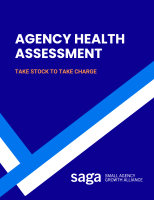Agency owners commonly ask me what they should be setting as target utilization rates for their employees.
That’s because they have read an article or heard a speaker talk about how they can measure their agency performance in part by looking at whether their account managers are at least 85 or 90 percent billable to clients.
While this sounds like a great idea, it carries with it some substantial problems that make it a poor management tool.
Employees will tell you what you want to hear
If you tell an employee that they should be 80 or 85 percent billable, chances are that their time sheets will reflect just that. Nobody wants to invite a difficult conversation by disappointing the boss if they can avoid it.
It’s not a matter of employees choosing to be dishonest, it is merely part of the people-pleasing culture that tends to inhabit agencies.
Even when it is true, it may not be a good idea. Setting arbitrary minimum targets encourages employees to spend more time on client work in order to “meet” those goals.
What you really want is accurate time reporting – and then use that information to make better decisions.
Utilization rates can mask other problems
Even when employees are hitting their billable targets, it may not mean that the work that you are doing is efficient and profitable.
That’s why project budgeting matters so much. Understanding how much work (and cost) goes into each client activity will help you to better manage (and price) your work in the future.
By looking at overall financial performance alongside individual project performance, you get the important information that you need in order to make better decisions.
Maximizing utilization rates makes growth harder
It seems counterintuitive, but if you are hitting all of your employee utilization targets, you will have a very difficult time growing your agency.
That’s because most utilization rate targets don’t account for having excess capacity to deploy when a new project comes along.
Now, you might argue that it is rare to have everyone on your team meet the utilization target, but if that’s the case then why are you focusing on it? There’s not much point in setting goals you don’t expect to be able to meet.
If you are at capacity and want to add new work, the most common solution is to overwork your team – at least for a period of time. But that usually also means cutting corners with existing clients and negatively impacting team morale.
Utilization rate targets discourage employee progress
When you tell an employee that they need to meet certain billable goals, you are telling them that other uses of their time are inherently less valuable and important.
That means that spending time on professional development or team collaboration will be viewed in a negative light. Since the highest utilization rate targets typically get assigned to the most junior employees, this often means that those who most need to work to develop their skills are the least able to do so.
Excessively high targets also contribute to employees feeling ground down and burned out. That’s especially true in agencies where the only way to achieve profitability is by hitting these numbers.
Everyone needs a little breathing room to do their jobs well.
Don’t set targets, but but do keep track
While you don’t want to manage to a specific utilization goal, it is helpful to know what those numbers are for your team.
Monitoring trends in utilization can be helpful in prioritizing resource needs or addressing overall management challenges.
If you find yourself falling short on financial performance agency-wide or at the client level, these utilization metrics can help you to identify underlying problems and solutions.
The key thing to remember is that you should never communicate specific utilization rate targets to individual employees, and you should focus on broader financial metrics as your primary management tool for profitability.










